Osteoporosis Drugs Market Size
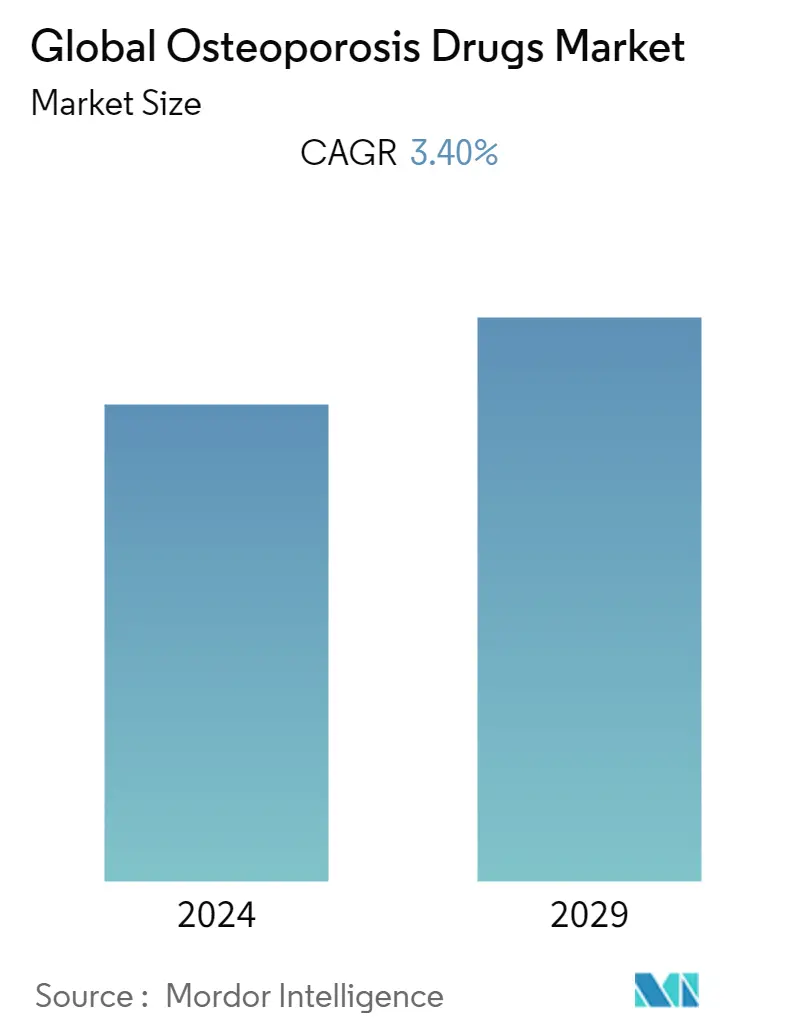
| Study Period | 2019 - 2029 |
| Base Year For Estimation | 2023 |
| Forecast Data Period | 2024 - 2029 |
| CAGR | 3.40 % |
| Fastest Growing Market | Asia Pacific |
| Largest Market | North America |
Major Players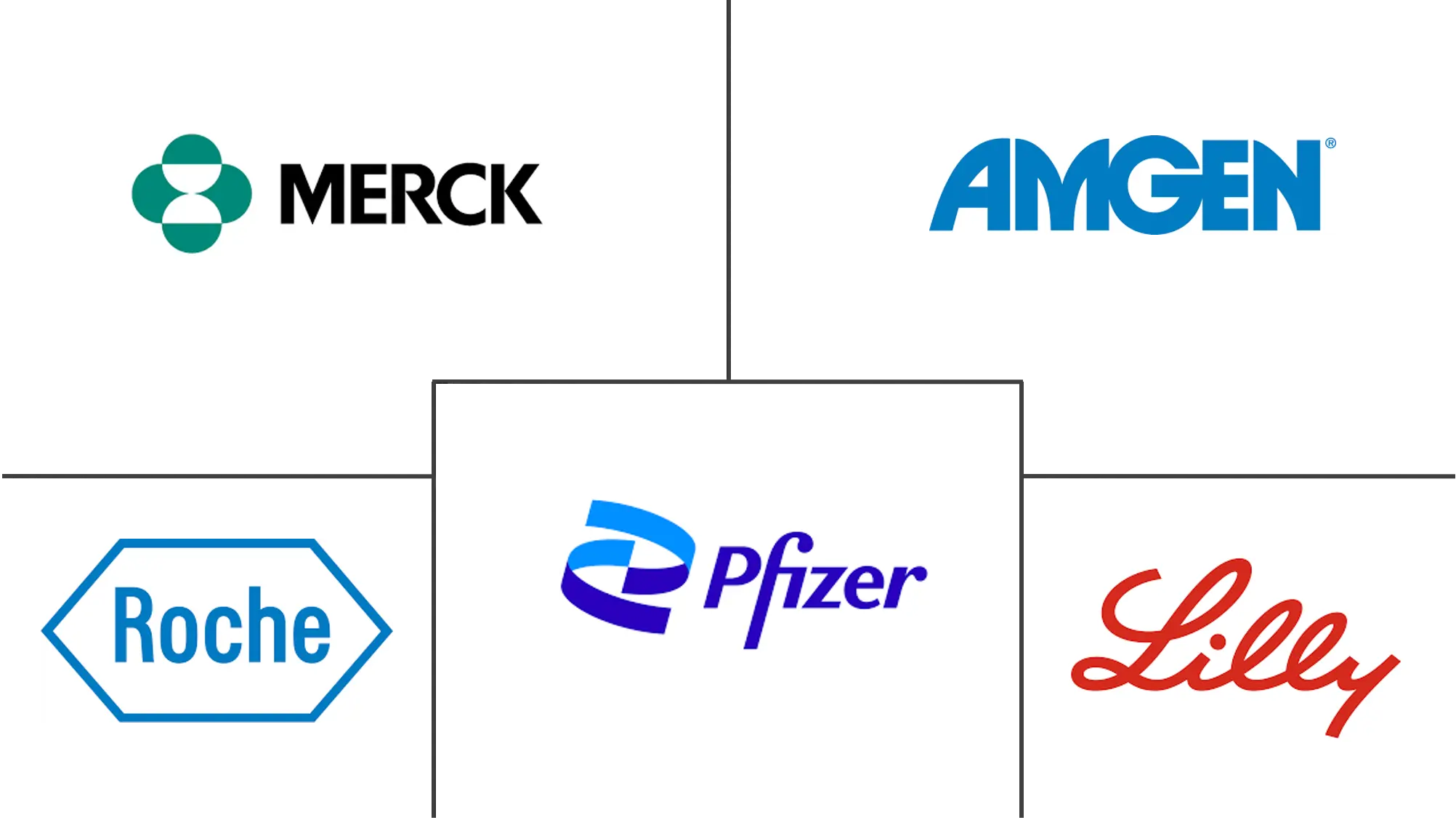
*Disclaimer: Major Players sorted in no particular order |
Osteoporosis Drugs Market Analysis
The osteoporosis drugs market is expected to record a CAGR of 3.4% during the forecast period (2022-2027).
Many therapies are being followed worldwide to find reliable COVID-19 treatments. Numerous studies have suggested that in addition to drugs used to treat infections, other drugs such as the drug osteoporosis may be helpful in the treatment of COVID-19, which may boost the market. For example, according to a study published in November 2020, "General treatment of osteoporosis may help reduce the incidence of COVID-19", treatments such as denosumab, zoledronate, and calcium, are used to treat osteoporosis and COVID-19. The study was conducted by the Pompeu Fabra University, Hospital del Mar Medical Research Institute (IMIM), and Pere Virgili Health Park. According to research, treatment with osteoporosis can reduce COVID-19 infection by 30-40%.
A major factor in the market's growth is an increase in the incidence of osteoporosis. According to the study titled "Spread and experience of diagnosing osteoporosis in postmenopausal women over the age of 50: Focus on social issues", published in March 2021, the prevalence of osteoporosis was 34.8%, with a diagnosis rate of 22.1% in South Korea, the highest. The increase in the number of young people worldwide prone to bone growth is another important factor in the market's growth. For example, according to the International Osteoporosis Foundation, in 2020, 1 in 5 men and 1 in 3 women over the age of 50 may experience osteoporosis fractures in their remaining life.
In addition, the growing investment in R&D by biotechnology and pharmaceutical companies is enhancing the market's growth. For example, in October 2020, the Italian pharmaceutical authority approved the testing of human clinics with raloxifene. It is a standard orthopedic drug that may help reduce the symptoms of COVID-19. Therefore, positive results from clinical trials can lead to new treatment options, thus boosting the market's growth. However, strict government regulations are hindering the growth of the market studied.
Osteoporosis Drugs Market Trends
This section covers the major market trends shaping the Osteoporosis Drugs Market according to our research experts:
The RANK Ligand Inhibitors Segment is Expected to Dominate the Market Over the Forecast Period
Rank ligand (RANKL) inhibitors are used to treat osteoporosis in patients at high risk of fracture. The high growth potential results from the positive patient outcomes associated with rank ligand inhibitors. Positive patient outcomes can be attributed to significant improvements in bone metabolism. Rank ligand inhibitors can also be used in combination with other drugs to convey the synergistic effect on the entire treatment system. The above-mentioned factor is also expected to be one of the key factors in generating profit. Other benefits associated with rank ligand inhibitors are a reduction in cellular bone density and an increase in bone mineral density, thus increasing their demand.
The Rank ligand may prevent COVID-19. According to a study conducted by a Spanish hospital, Del Mar Hospital, by 2020, denosumab aimed for the RANK/RANKL system, which maintains balance in the skeletal system. It activates the lymph node T-cell and affects the immune system. Inhibition of this system reduces cytokines that cause inflammation in the body and helps control inflammation, which is one of the major risk factors for COVID-19. Thus, due to the widespread use of RANKL, the segment is likely to grow rapidly.
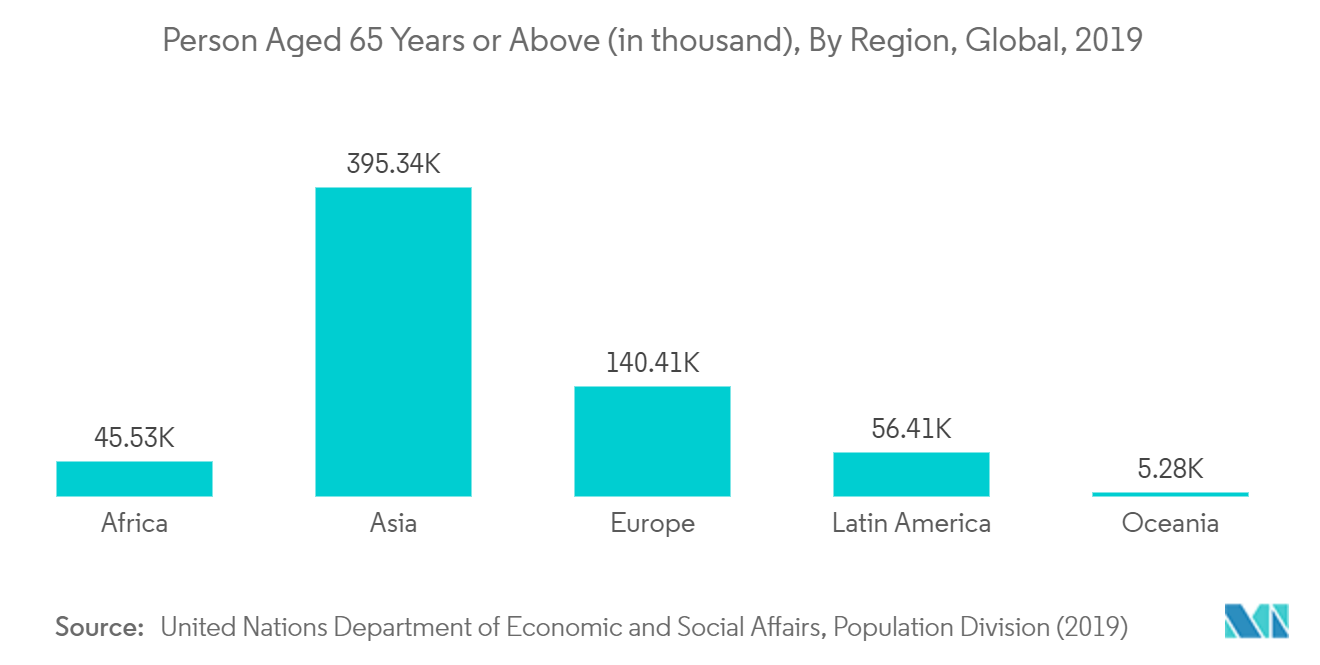
North America Dominates the Market, and May Continue a Similar Trend During the Forecast Period
North America is expected to dominate the overall osteoporosis drugs market throughout the forecast period. The market growth is due to the presence of key players, the high prevalence of osteoporosis patients in the region, established healthcare infrastructure, and the availability of branded drugs.
The United States has the largest market share due to the increasing adult population, a growing number of patients in the country, and several collaborative efforts initiated by large companies to improve their capabilities and ensure higher medical standards. For example, according to the National Osteoporosis Foundation (NOF), since 2020, more than 10 million people in the United States have been diagnosed with osteoporosis, which is more common in menopause. Therefore, the increasing incidence due to menopause in women is expected to be a significant growth factor contributing to the regional drug market for osteoporosis.
COVID-19 disrupts and delays the treatment of many patients with osteoporosis. Hence, the American Society for Bone and Mineral Research (ASBMR) set up an orthopedic committee to oversee the treatment of targeted diseases during the pandemic. For example, in April 2020, a paper on the evidence behind the recommendations was published in the official journal of the American Society for Bone and Mineral Research (ASBMR), Journal of Bone and Mineral Research. The guidelines recommend that patients should continue with osteoporosis medication safely. The introduction of new oral bisphosphonate treatment can be done remotely and should not be delayed in patients at high risk of fracture. Therefore, COVID-19 is expected to significantly impact the market's growth in North America.
The growing demand is also due to collaborative research programs implemented by major health organizations and companies and the development of new products that constantly strive to improve alternative therapies in the current market environment. For example, in 2019, Amgen announced that the US FDA approved its Evenity (romosozumab-aqqg) for the treatment of osteoporosis in postmenopausal women at high risk of fracture. This factor may open new opportunities for the market's growth in the region.
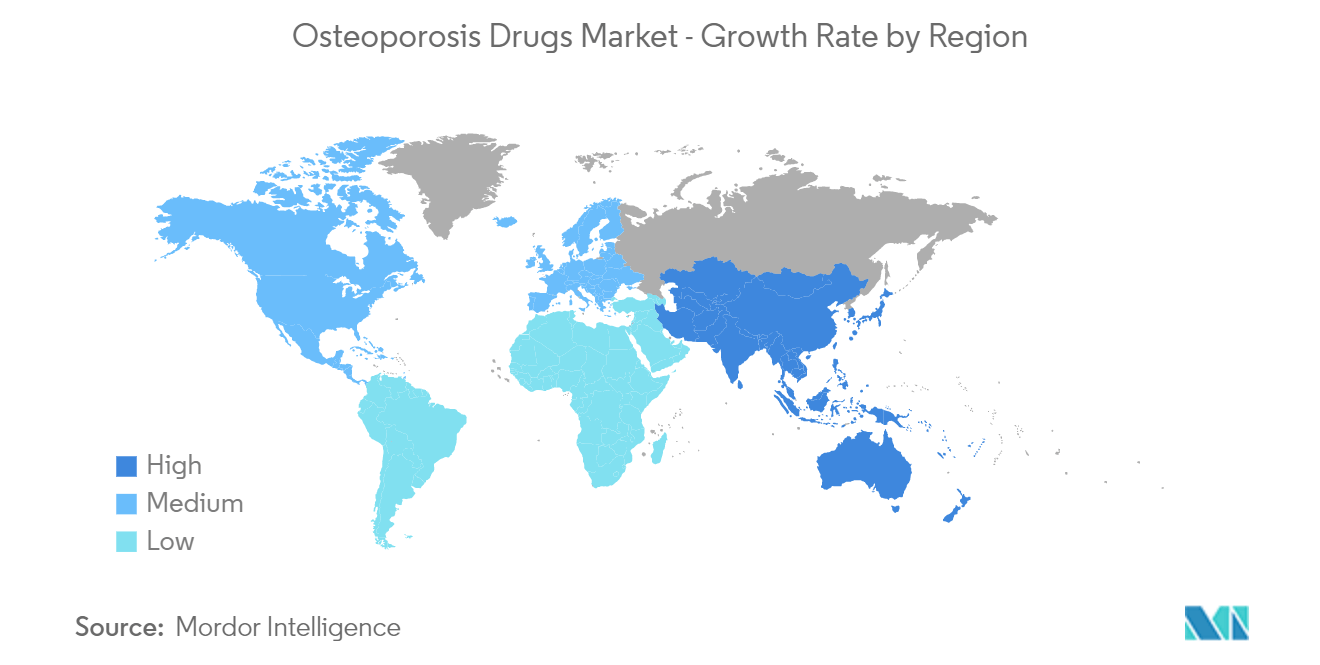
Osteoporosis Drugs Industry Overview
The osteoporosis drugs market is moderately competitive and consists of several major players. Some of the companies currently dominating the market are Pfizer Inc., Eli Lily and Company, F. Hoffmann La Roche, Merck & Co. Inc., Amgen Inc., Radius Health Inc., Teva Pharmaceutical Industries Ltd, GlaxoSmithKline PLC, Novartis International AG, and Actavis PLC. This industry is anticipated to witness intense competition during the forecast period due to the rising incorporation of collaborative strategies among the key players to sustain the competitive position. The other strategies incorporated are high R&D investments, mergers and acquisitions, and agreements for drug development.
Osteoporosis Drugs Market Leaders
-
Eli Lily and Company
-
F. Hoffmann La Roche
-
Pfizer Inc.
-
Merck & Co. Inc.
-
Amgen Inc.
*Disclaimer: Major Players sorted in no particular order
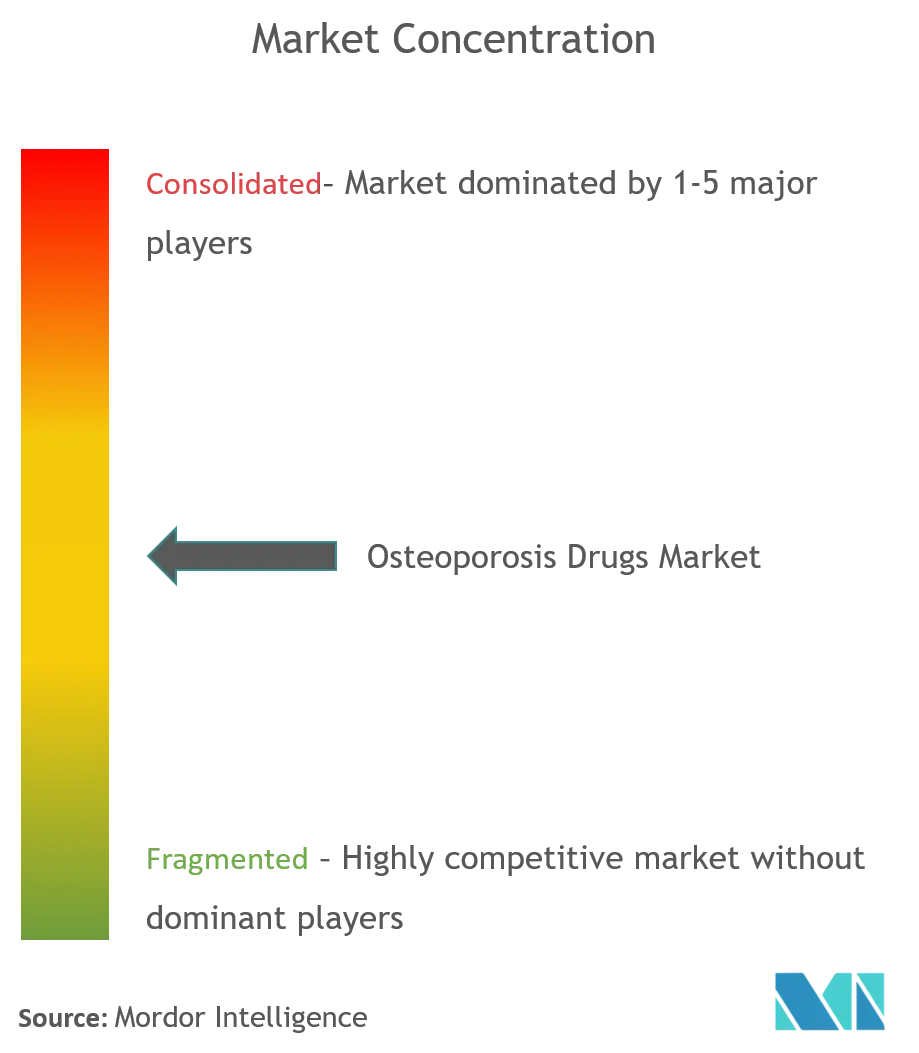
Osteoporosis Drugs Market News
- In August 2021, Enzene Biosciences Ltd received Marketing Authorization (MA) from the Drug Controller General of India (DCGI) for its biosimilar drug, denosumab, indicated for the treatment of osteoporosis in adults.
- In January 2021, Theramex, a London-headquartered pharmaceutical company, launched the osteoporosis medicine Livogiva in Europe.
Osteoporosis Drugs Market Report - Table of Contents
1. INTRODUCTION
- 1.1 Study Assumptions and Market Definition
- 1.2 Scope of the Study
2. RESEARCH METHODOLOGY
3. EXECUTIVE SUMMARY
4. MARKET DYNAMICS
- 4.1 Market Overview
-
4.2 Market Drivers
- 4.2.1 Increasing Incidences of Osteoporosis
- 4.2.2 Rise in the Geriatric Populations
-
4.3 Market Restraints
- 4.3.1 Stringent Regulatory Environment
-
4.4 Porter's Five Forces Analysis
- 4.4.1 Threat of New Entrants
- 4.4.2 Bargaining Power of Buyers/Consumers
- 4.4.3 Bargaining Power of Suppliers
- 4.4.4 Threat of Substitute Products
- 4.4.5 Intensity of Competitive Rivalry
5. MARKET SEGMENTATION (Market Size by Value - USD million)
-
5.1 By Drug Type
- 5.1.1 Parathyroid Hormone Therapy
- 5.1.2 Bisphosphonates
- 5.1.3 Calcitonin
- 5.1.4 RANKL Inhibitors
- 5.1.5 Other Drug Types
-
5.2 By Application
- 5.2.1 Primary Osteoporosis
- 5.2.2 Secondary Osteoporosis
-
5.3 By Geography
- 5.3.1 North America
- 5.3.1.1 United States
- 5.3.1.2 Canada
- 5.3.1.3 Mexico
- 5.3.2 Europe
- 5.3.2.1 Germany
- 5.3.2.2 United Kingdom
- 5.3.2.3 France
- 5.3.2.4 Italy
- 5.3.2.5 Spain
- 5.3.2.6 Rest of Europe
- 5.3.3 Asia-Pacific
- 5.3.3.1 China
- 5.3.3.2 Japan
- 5.3.3.3 India
- 5.3.3.4 Australia
- 5.3.3.5 South Korea
- 5.3.3.6 Rest of Asia-Pacific
- 5.3.4 Middle-East and Africa
- 5.3.4.1 GCC
- 5.3.4.2 South Africa
- 5.3.4.3 Rest of Middle-East and Africa
- 5.3.5 South America
- 5.3.5.1 Brazil
- 5.3.5.2 Argentina
- 5.3.5.3 Rest of South America
6. COMPETITIVE LANDSCAPE
-
6.1 Company Profiles
- 6.1.1 Pfizer Inc.
- 6.1.2 Eli Lily and Company
- 6.1.3 F. Hoffmann La Roche
- 6.1.4 Merck & Co. Inc.
- 6.1.5 Amgen Inc.
- 6.1.6 Radius Health Inc.
- 6.1.7 Teva Pharmaceutical Industries Ltd
- 6.1.8 GlaxoSmithKline PLC
- 6.1.9 Novartis International AG
- 6.1.10 Actavis PLC
- *List Not Exhaustive
7. MARKET OPPORTUNITIES AND FUTURE TRENDS
** Subject To AvailablityOsteoporosis Drugs Industry Segmentation
As per the scope of the report, osteoporosis makes a person's bones weak and more likely to break. The market is segmented by drug type, application, and geography. The market report also covers the estimated market sizes and trends for 17 countries across major regions globally. The report offers the market size and forecast in value (USD billion) for the above segments.
| By Drug Type | Parathyroid Hormone Therapy | |
| Bisphosphonates | ||
| Calcitonin | ||
| RANKL Inhibitors | ||
| Other Drug Types | ||
| By Application | Primary Osteoporosis | |
| Secondary Osteoporosis | ||
| By Geography | North America | United States |
| Canada | ||
| Mexico | ||
| By Geography | Europe | Germany |
| United Kingdom | ||
| France | ||
| Italy | ||
| Spain | ||
| Rest of Europe | ||
| By Geography | Asia-Pacific | China |
| Japan | ||
| India | ||
| Australia | ||
| South Korea | ||
| Rest of Asia-Pacific | ||
| By Geography | Middle-East and Africa | GCC |
| South Africa | ||
| Rest of Middle-East and Africa | ||
| By Geography | South America | Brazil |
| Argentina | ||
| Rest of South America |
Osteoporosis Drugs Market Research FAQs
What is the current Global Osteoporosis Drugs Market size?
The Global Osteoporosis Drugs Market is projected to register a CAGR of 3.40% during the forecast period (2024-2029)
Who are the key players in Global Osteoporosis Drugs Market?
Eli Lily and Company, F. Hoffmann La Roche, Pfizer Inc., Merck & Co. Inc. and Amgen Inc. are the major companies operating in the Global Osteoporosis Drugs Market.
Which is the fastest growing region in Global Osteoporosis Drugs Market?
Asia Pacific is estimated to grow at the highest CAGR over the forecast period (2024-2029).
Which region has the biggest share in Global Osteoporosis Drugs Market?
In 2024, the North America accounts for the largest market share in Global Osteoporosis Drugs Market.
What years does this Global Osteoporosis Drugs Market cover?
The report covers the Global Osteoporosis Drugs Market historical market size for years: 2019, 2020, 2021, 2022 and 2023. The report also forecasts the Global Osteoporosis Drugs Market size for years: 2024, 2025, 2026, 2027, 2028 and 2029.
What are the emerging trends in the Osteoporosis Drugs Market?
The emerging trends in the Osteoporosis Drugs Market are a) Development and potential application of biologic drugs that target bone formation and resorption processes b) Exploring alternative delivery methods for improved patient compliance and potentially faster-acting medications
Osteoporosis Treatment Industry Report
The global osteoporosis drugs market is on the rise, propelled by medical advancements and an increasing elderly population susceptible to osteoporosis. Innovation in drug development is robust, particularly with new treatments like unique-cell based approaches and prostacyclin analogs. Key segments such as bisphosphonates and SGC stimulators are gaining traction for their potential in treating cardiopulmonary conditions. Oral medications remain preferred due to ease of administration, with growing interest in anabolic agents for patients at high risk of fractures. North America leads the market, supported by strong healthcare policies and infrastructure that facilitate the swift adoption of new treatments. Technological advancements in bone density scanning and drug delivery are improving treatment outcomes, with a notable shift towards biologic therapies and fracture prevention. Additionally, the integration of AI in drug development is enhancing personalization and efficacy in treatments. For further insights and a comprehensive market forecast, a detailed analysis is available for free download from Mordor Intelligence™.



